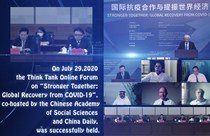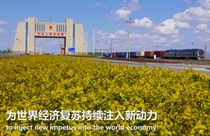Promising future of Internet Plus
Author : Li Yongjian Source : 2015-06-04
The Internet Plus strategy will bring major changes not only to the marketing channel but also to the consumer market, brand recognition, product design, technical innovation and production mode. It is a new model of advancing industrial efficiency based on the revolution of demand and supply structures.
According to the calculation of related institutions, only 25 percent of Internet-driven GDP comes from online industries while the rest comes from the integration of traditional industries with the Internet. It can therefore be expected that the Internet Plus strategy will provide a new way forward for China’s economy.
The China Internet Network Information Center released its 35th Statistical Report on Internet Development in China. The report revealed that online retail sales hit 2.8 trillion yuan ($451.6 billion) in 2014, growing annually by 49.7 percent and representing 10.6 percent of total retail sales at the same period. Based on these figures, China has overtaken the US to become the world’s largest online retail sales market.
The increasing application of the Internet offers an engine for economic development. A recent study found that China’s GDP will increase by 4.7225 trillion yuan ($761.6 billion) by 2020 strictly based on the application of the Internet in the distribution industry, accounting for 6 percent of total GDP.
The Internet’s influence on the economy is nowadays mainly reflected by the distribution industry.
The Internet has connected many enterprises that distribute their commodities to different places. These companies have access to a new space that allows them to exchange geographical and virtual information together. Within this new online space, information and capital streams can be freely mobilized to improve the efficiency of traditional commerce and trade.
There are some intermediate links between producers and consumers that raise distribution costs, including transportation, wholesale and retail expenses. The Internet brings enterprises directly into contact with consumers, largely reducing distribution costs. Some researchers optimistically predict that 50 percent of wholesale and retail costs can be cut through the Internet.
Empirical research has found that the sales cost of online goods is 6 to 16 percent cheaper than comparative retail costs. Numerous factors including cheaper prices, greater choice and lower purchasing costs fuel consumer demand for online goods.
Multinational management consulting firm McKinsey & Company has predicted that private consumption will increase by 4 to 7 percent between now and 2020 due to the Internet.
The development of Internet Plus is contrary to the production process, which means it first penetrates the consumer terminal and then middle chains, including circulation. The departments of manufacturing, as well as research and development, are less affected by the Internet. However, the Internet will penetrate into these departments in future with the aim of enhancing operation efficiency and innovation capability, thus providing a solid foundation for constructing a powerful manufacturing sector.
In an era of industrialization, a large-scale distribution system has been established. There is a stark gap between producers and consumers within this system, which makes it difficult to satisfy consumer demand. The Internet Plus strategy greatly narrows the gap between producers and consumers to realize consumer-centered production.
The efficiency of enterprises can also be enhanced through the Internet. For example, application of the Internet promotes the informatization and the utilization of data within each chain, greatly integrating value and supply chains and making the management of enterprises more scientific.
Mass innovation is one of the prominent characteristics of a modern economy.
The development of the Internet leads all individuals to engage in business innovation through large-scale social collaboration, rather than following the traditional mode of setting up an enterprise, opening market channels, attracting investment and expanding production.
For example, each individual can play the role of angel investor through the Internet plus finance. Based on the seamless connection of the Internet, the Internet of Things, logistics networks and 3D printing, individuals can fully participate in the whole process of design, production, promotion and marketing, to share product profits and spearhead greater innovation.
Li Yongjian is an associate research fellow from the National Academy of Economic Strategy at the Chinese Academy of Social Sciences.
The Chinese link: http://naes.org.cn/article/34852
Translated by Chen Meina
Revised by Tom Fearon
Ye Shengtao made Chinese fairy tales from a wilderness
Ye Shengtao (1894–1988) created the first collection of fairy tales in the history of Chinese children’s literature...
-
How northern ethnicities integrated into Chinese nation
2023-09-18
-
Mogao caves
2023-09-12
-
Mogao Grottoes as ‘a place of pilgrimage’
2023-09-12
-
Time-honored architectural traditions in China
2023-08-29
-
Disentangling the civilizational evolution of China
2023-08-28
-
AI ethics in science fiction
2023-08-23














 2011-2013 by www.cssn.cn. All Rights Reserved
2011-2013 by www.cssn.cn. All Rights Reserved